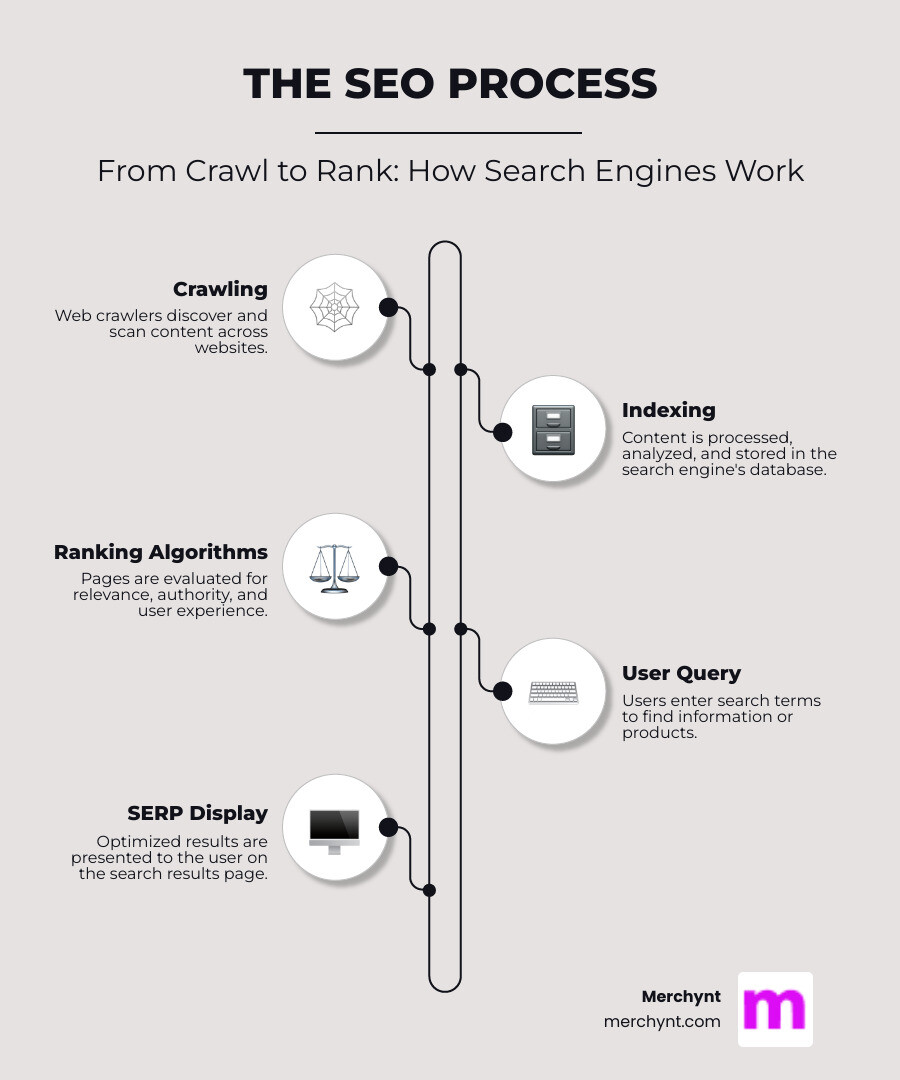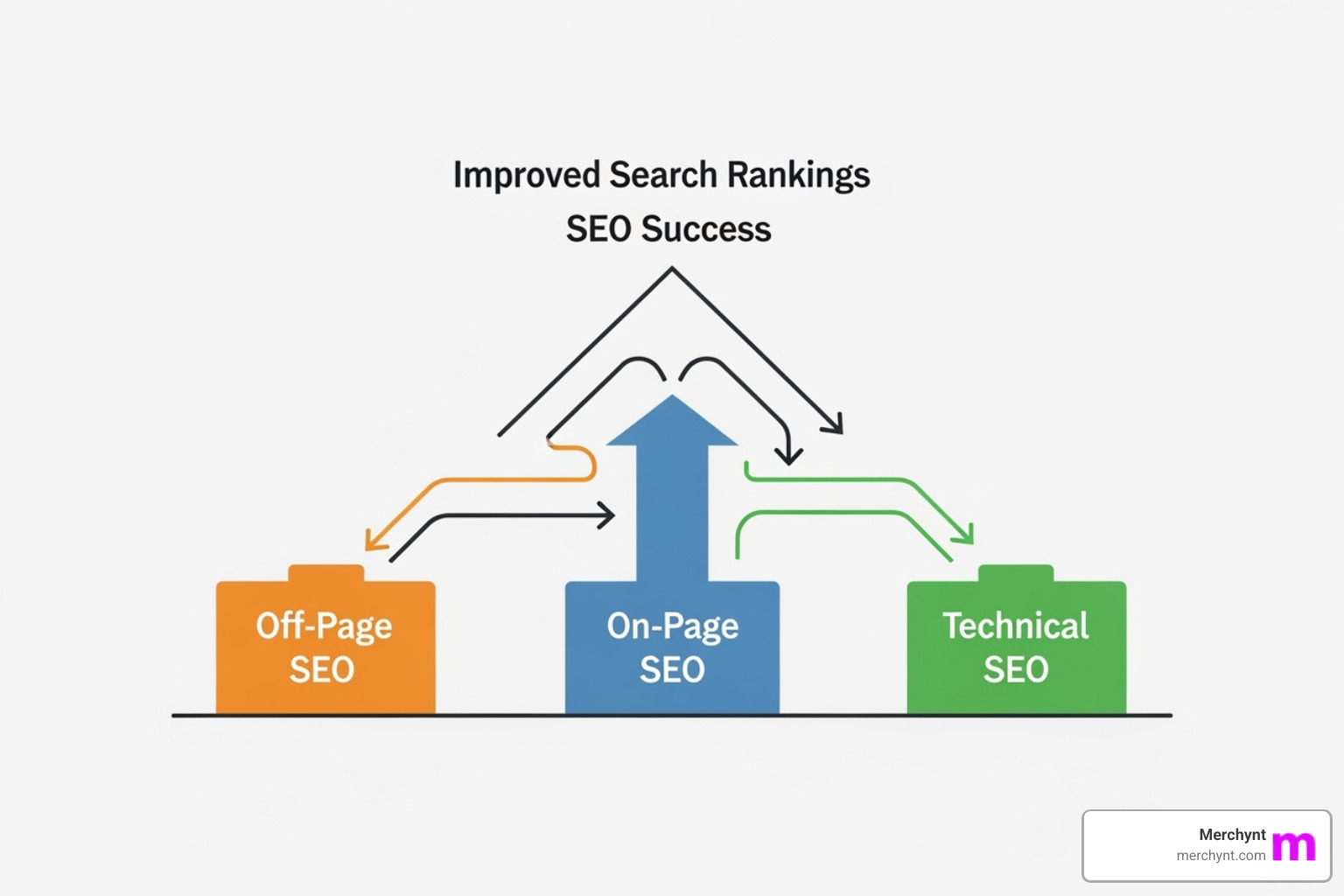
Why SEO Optimization is Essential for Business Success
SEO optimization is the practice of improving your website to increase its visibility when people search for products or services related to your business in search engines like Google. Here's what you need to know:
Core Components of SEO Optimization:
- On-page SEO - Optimizing content, keywords, and HTML elements on your website
- Off-page SEO - Building authority through backlinks and external signals
- Technical SEO - Ensuring your site loads fast, works on mobile, and can be crawled by search engines
Key Benefits:
- Increased organic website traffic
- Higher search engine rankings
- More qualified leads and customers
- Better return on investment (49% of marketers report organic search as their highest ROI channel)
Search engines work by crawling websites, indexing content, and ranking pages based on relevance and authority. When done right, SEO optimization helps your business appear higher in search results, driving more potential customers to your website without paying for ads.
Whether you're a small business owner struggling to get found online or an agency looking to improve client results, understanding SEO fundamentals is crucial for digital marketing success.
I'm Justin Silverman, and I've helped thousands of small businesses improve their online visibility through automated SEO optimization tools and strategies at Merchynt. After growing multiple software divisions and launching award-winning products, I've seen how proper SEO can transform a business's digital presence.

What is SEO and Why Does It Matter for Your Business?
SEO, or Search Engine Optimization, is the process of making your website more appealing to search engines like Google. The goal is to have your business appear prominently when people search for what you offer. With over 3.5 billion Google searches daily, being visible is crucial. Otherwise, you're like a great restaurant hidden in an alley with no sign.
The data is clear: 49% of marketers report that organic search delivers the highest return on investment of any marketing channel. Investing in SEO optimization brings genuine results. A solid strategy, like our local SEO services, can fundamentally transform how customers find your business.
The Main Benefits of SEO
Effective SEO optimization delivers benefits far beyond simple website visits.
- More website traffic: Higher search rankings naturally lead more people to your site. This isn't just any traffic; these are people actively searching for your products or services.
- More customers: Visitors from search are often ready to buy. With 81% of people researching online before major purchases, you're meeting them when they're already in buying mode.
- Better reputation: Ranking at the top of Google builds trust. People psychologically view top results as the most credible and authoritative options.
- Higher ROI: Unlike paid ads, SEO builds momentum. Your efforts today can continue bringing in customers for months or years, making it a highly attractive investment.
- Cost-effective marketing: SEO levels the playing field, allowing small businesses to compete with larger companies through smart strategy rather than a massive budget.
How Search Engines Like Google Determine Rankings
Google's process for delivering search results is a highly efficient, three-step operation.
Crawling: Google sends out automated programs called crawlers to explore the internet, following links to find and read content on websites. They analyze your text, images, and overall site structure.
Indexing: After crawling, Google organizes the finded information into a massive database, or index. This catalog allows the search engine to quickly retrieve relevant pages. If your site has technical issues, it may not be indexed correctly.
Ranking algorithms: When you search, Google's algorithms sort through billions of pages to find the most relevant results. These algorithms consider hundreds of factors and are constantly evolving to better understand user needs.
Two other key factors influence rankings:
- User interaction: Google watches how users interact with search results. If they click your link and stay on your site, it's a positive signal. If they immediately return to the search results, it's a negative one.
- E-E-A-T: This framework stands for Experience, Expertise, Authoritativeness, and Trustworthiness. Google uses it to evaluate content quality, prioritizing pages that are genuinely helpful, accurate, and created by credible sources.
Understanding these factors shows that SEO optimization is about creating valuable, trustworthy experiences for customers, not just using keywords.

The Core Pillars of SEO: On-Page, Off-Page, and Technical
Effective SEO optimization rests on three interconnected pillars: Technical SEO (the foundation), On-Page SEO (the content and structure), and Off-Page SEO (the reputation). Your technical setup allows search engines to find your site, on-page elements help them understand your content, and off-page signals prove your authority and trustworthiness to Google.
| Pillar | Focus | Key Activities | Impact |
|---|---|---|---|
| On-Page SEO | Optimizing elements on your website to improve relevance and user experience. | Keyword research, content quality, title tags, meta descriptions, header tags, image alt text, internal linking. | Helps search engines understand your content and match it to user queries. |
| Off-Page SEO | Activities done outside your website to improve authority and trust. | Backlink building, brand mentions, social media signals, customer reviews. | Signals to search engines that your site is trustworthy and popular. |
| Technical SEO | Ensuring your website's infrastructure allows search engines to crawl, index, and understand it. | Page speed, mobile-friendliness, HTTPS, Core Web Vitals, XML sitemaps, schema markup, URL structure. | Makes your site accessible and easy for search engines to process, improving user experience. |

Essential On-Page SEO Optimization Steps
On-page SEO involves optimizing individual pages to create content that both search engines and users love.
- Keyword Research: This is the starting point. You must understand the terms your customers use to find your services. Understanding user intent (are they learning or buying?) is key. For tracking performance, see The Definitive Guide to Mastering Keyword Ranking Reports.
- Content Quality: Google prioritizes helpful, expert content. Your writing must demonstrate real experience and answer user questions effectively, not just stuff keywords.
- Title Tags & Meta Descriptions: Your title tag (50-60 characters) is the page's headline in search results. The meta description (150-160 characters) is your sales pitch to convince users to click.
- Header Tags (H1, H2, H3): These structure your content, creating a roadmap for readers and search engines. Use one H1 for the main topic and H2s/H3s for subtopics.
- Image Alt Text & Internal Linking: Alt text describes images for search engines and accessibility, providing another place for relevant keywords. Internal links connect your pages, guiding users and spreading SEO authority throughout your site.
How to Effectively Perform Off-Page SEO Optimization
Off-page SEO builds your website's reputation across the internet, acting as digital word-of-mouth.
- Backlinks: These are links from other sites to yours and are a core ranking factor. Quality trumps quantity; one link from a respected industry site is worth more than dozens from low-quality ones.
- Link Building: This involves creating content so valuable that others want to link to it, such as original research or helpful guides. Guest posting on relevant blogs is another effective tactic.
- Brand Mentions & Social Signals: Google notices when your brand is discussed online, even without a link. Social media shares amplify your content's reach, leading to more traffic and potential backlinks.
- Customer Reviews: For local businesses, positive reviews on Google Business Profile are crucial. They directly impact local rankings and build the trust needed to convert searchers into customers. Learn How to Get Customer Reviews on Google Maps for Restaurants.
Crucial Technical SEO Elements to Consider
Technical SEO is the foundation of your site. If search engines can't crawl it, your other efforts are wasted.
- Page Speed & Mobile-First: Sites should load in under three seconds. Google uses mobile-first indexing, meaning your mobile site's performance is paramount. A slow or broken mobile experience will harm your rankings.
- Site Security (HTTPS): An HTTPS certificate (the padlock in the browser) is a confirmed ranking factor that secures user data and builds trust.
- Core Web Vitals: These metrics measure user experience, including loading speed (Largest Contentful Paint), interactivity (Interaction to Next Paint), and visual stability (Cumulative Layout Shift). Google uses these as direct ranking signals, as detailed in their Page Experience signals.
- Sitemaps & Schema: An XML sitemap is a roadmap of your site for Google. Schema markup is code that helps search engines understand your content, enabling rich results like star ratings or prices in the SERP.
- URL Structure: Use clean, descriptive URLs (e.g.,
/local-seo-services) instead of long, confusing ones. This helps both users and search engines understand the page's topic at a glance.
Essential Tools for Analysis and Improvement
SEO optimization tools are your digital compass and toolkit. Without them, you're navigating the complex world of search rankings blindfolded. Many powerful tools are free, and paid options often pay for themselves through improved results.
- Google Search Console: This free tool is your direct line to Google. It shows how Google sees your site, what keywords people use to find you, and any technical issues holding you back.
- Google Analytics: This tool reveals what visitors do on your site: how long they stay, which pages they visit, and where they came from. It helps you understand if your SEO efforts are attracting the right audience.
- Keyword Research Tools: Dedicated keyword research platforms help you find what customers are searching for and analyze competitiveness. Look for features like search volume, keyword difficulty, SERP analysis, and long-tail keyword findy.
- Backlink Analysis Tools: Backlink analysis platforms help you examine your backlink profile, see who links to you, and research competitor strategies to identify high-quality link opportunities.
- Rank Trackers: Monitoring your keyword rankings over time is essential. Many platforms include this, and our SEO Keywords Ranking Tool offers a dedicated solution.
- Website Audit Tools: Site auditing and crawling tools perform a health check on your site, identifying technical issues like broken links, duplicate content, and crawl errors.
For local businesses, specialized tools are a game-changer. This is where Merchynt's Paige shines. Paige is our AI-powered, fully automated SEO optimization tool for Google Business Profile management. It focuses on what local businesses need most: ranking higher on Google Maps and in local search results.
What makes Paige special is its automation. While other tools require manual work, Paige handles your Google Business Profile optimization automatically, continuously improving your local rankings. Our customers consistently tell us that Paige "simply works and gets results," backed by hundreds of success stories.
To dive deeper into local analytics, our Google Business Profile Heatmap Report Guide: The Best GMB Reporting Tools with Geogrids & Heatmaps offers great insights. The key is to start with free tools and add specialized ones as you grow.
The Evolution and Future of SEO
The world of SEO optimization is constantly evolving. What began as simple keyword matching has become a sophisticated discipline focused on user intent and experience.

Key shifts in SEO's history include:
- From Keywords to Intent: Early SEO involved keyword stuffing. Google's PageRank (1998) shifted focus to backlinks. Later, updates like Panda, Penguin, and Hummingbird forced the industry to prioritize content quality, link authority, and the context behind search queries.
- Mobile-First Indexing: Since 2016, Google has prioritized the mobile version of websites for ranking, reflecting the dominance of mobile search.
- The Rise of AI: Artificial intelligence is revolutionizing search. Google's algorithms use AI to better interpret queries, and generative AI tools like ChatGPT are changing how users find information, often getting answers without clicking a link.
This has led to new optimization fields like Generative Engine Optimization (GEO), which focuses on making content citable by AI, and Answer Engine Optimization (AEO) for voice assistants. These fall under the umbrella of Artificial Intelligence Optimization (AIO). At Merchynt, our AI-powered tool Paige embodies this forward-thinking approach. Learn more about AI for SEO.
SEO Across International Markets
International SEO optimization requires adapting to different markets. While Google dominates in many countries, it's not the only player.
- Regional Search Engines: In China, Baidu is the leader, while Yandex dominates in Russia. Each has unique ranking factors.
- Multilingual vs. Localization: True international SEO goes beyond translation. It involves cultural localization—adapting content, imagery, and user experience to local nuances and behaviors.
- Technical Signals: Hreflang tags tell search engines which language and region a page targets, preventing duplicate content issues. Geotargeting strategies like using country-code top-level domains (ccTLDs) (e.g.,
.defor Germany) and Content Delivery Networks (CDNs) also send strong local relevance signals.
Frequently Asked Questions about SEO Optimization
Here are answers to the most common questions businesses have about SEO optimization.
How long does SEO take to show results?
SEO is a long-term strategy, not an overnight fix. Most businesses see meaningful improvements within three to six months of consistent effort, a timeline confirmed by marketing professionals. The wait is worthwhile because SEO delivers compounding results. Unlike paid ads, which stop when you stop paying, organic rankings generate traffic continuously. Patience is key; SEO is a marathon, not a sprint, and the sustainable traffic it generates is a valuable long-term asset.
Can I do SEO myself?
Yes, many business owners can handle their own SEO optimization with dedication and the right resources, like Google's SEO Starter Guide: The Basics. Many effective strategies, like writing helpful content or optimizing a Google Business Profile, are very accessible.
However, SEO can be complex and time-consuming. This is where tools become invaluable. They automate tasks and provide guidance. For local businesses, our Paige AI tool automates Google Business Profile optimization, letting you focus on your business. Consider professional help if you're in a competitive market or lack the time, as the investment can pay for itself in better, faster results.
What's the difference between SEO and SEM?
The terms are related but distinct. Search Engine Optimization (SEO) focuses exclusively on earning organic (unpaid) traffic through content optimization, backlink building, and technical improvements.
Search Engine Marketing (SEM) is a broader term that includes both SEO and paid advertising (like Google Ads). Think of SEM as your total search marketing strategy. If you're paying for clicks, it's paid search; if you're earning clicks, it's SEO. The most successful businesses often use an integrated strategy, using paid ads for immediate visibility while building a long-term organic presence with SEO.
Conclusion
We've taken quite a journey together today, exploring the fascinating world of SEO optimization from its fundamental principles to the exciting possibilities that lie ahead. Through our discussion, we've finded that successful SEO isn't just about one magic trick – it's built on three solid pillars that work together: On-Page SEO (making your content shine), Off-Page SEO (building your reputation), and Technical SEO (ensuring everything runs smoothly behind the scenes).
Here's what I want you to remember: SEO optimization isn't a "set it and forget it" strategy. It's more like tending a garden – it requires consistent care, regular attention, and patience to see it flourish. The digital landscape keeps evolving, especially with AI reshaping how people search and find information. But the core principle remains unchanged: businesses need to be visible where their customers are looking.
The beauty of SEO lies in its long-term value. While it might take months to see significant results, the organic traffic and credibility you build compound over time. Unlike paid advertising where results stop the moment you stop spending, good SEO keeps working for you day and night.
At Merchynt, we've seen how overwhelming SEO can feel for busy business owners. That's exactly why we created Paige, our AI-powered solution that takes the complexity out of local SEO optimization. Paige handles your Google Business Profile management automatically, helping you climb higher in Google Search and Google Maps so local customers can find your business effortlessly.
What sets Paige apart? It's truly automated – no constant manual work required. Our customers consistently tell us that Paige "simply works and actually gets results." With hundreds of 5-star reviews across Google and Trustpilot, and recognition as a Top Google Marketing company, we're proud to help businesses succeed online.
Ready to see where your local SEO stands right now? Get a free GBP audit with our tool and find exactly what's working (and what isn't) with your Google Business Profile. It's the perfect first step toward mastering your local search presence!
About Author

